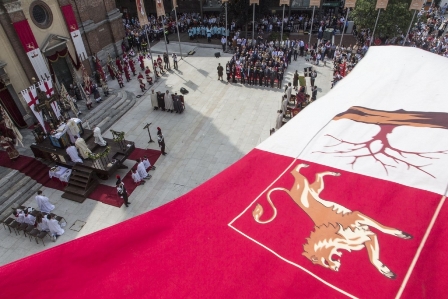
WTI Magazine #61 2015 May, 29
Author : folclore.it Translation by:
The Feast of the "carroccio" (a four-wheeled war alta) is the set of commemorative events of the Battle of Legnano, which on May 29, 1176 saw the victory of the allies in the Lombard League over Prince Frederick I Barbarossa. The victory is attributed by tradition to Alberto da Giussano and to the "Compagnia della morte" (Death Company) commanded by him and gathered around the "carroccio", the bullock cart symbol of municipal freedom, on which Mass was celebrated before the battle.
One of the characteristic of the festival, which requires months of preparation and work done in the manor houses, is the historic parade: which, along with the horse race, is held on the last Sunday of May.
Over a thousand figures wear costumes and bring objects made according to the requirements of a special committee which vets the relevance of tools and apparel with the medieval period represented.
Each district in the historic carousel that winds through the streets of the city, from the center to the sports field, home of the horse race, has a theme, representing an aspect of life in the Middle Ages, which can be that of the armed men, the nobles, the courtiers, the musicians and jugglers, the peasants or the magicians.
The conclusion of the event is represented by the Palio di Legnano (the contest of Legnano), ran by eight horses, one for each district, ridden bareback by the jockeys who, after having played two eliminatory heats of four rounds, will compete in the final five laps.
As for the Palio di Siena, the winning district receives the "Croce di Ariberto" (Aribert Cross) which will preserved in their own church until the following year.



